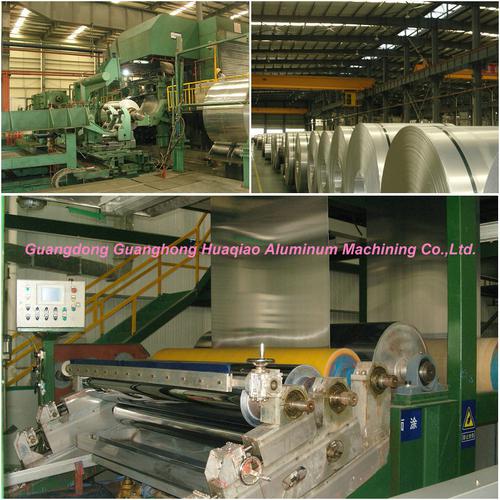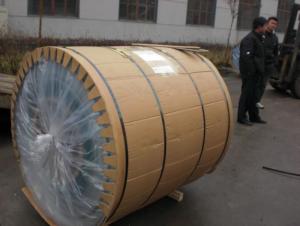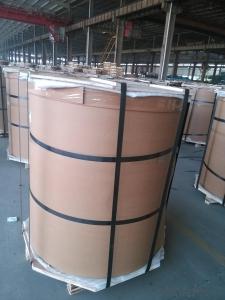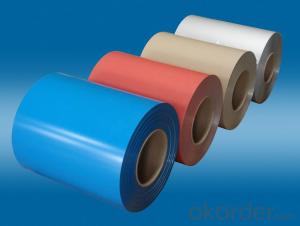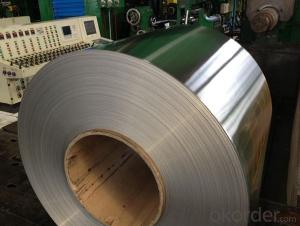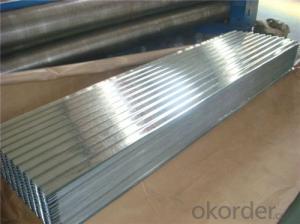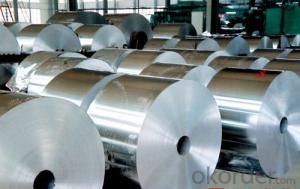Cold Casting Aluminum Mill Finish Rolls for Roofing Sheet Coils
- Loading Port:
- China Main Port
- Payment Terms:
- TT OR LC
- Min Order Qty:
- -
- Supply Capability:
- -
OKorder Service Pledge
OKorder Financial Service
You Might Also Like
Cans cover (ring) pre-coated plates
First, the raw materials
Aluminum lid and pull the main substrate of aluminum from the southwest andNanshan Aluminum, the use of aluminum-magnesium alloy 5182H19, 5052H19. Itsproducts in the normal substrates of manganese and magnesium components addedto increase the tensile strength and elongation. Han and the lotion by theGerman food-grade chrome HD agent, the United States PPG epoxy phenolicpackaging coatings, and high-end DOS oil
Second, applications
Division I professional production of DOS card and aluminum cans with a coatingfor cans of the lid and pull the coated aluminum is widely used in beverage,beer, rice pudding, tea, cigarettes, cans and other products packaging. U.S.imports of food ash using electrostatic spray wax, cut by large waves, transverseshear, longitudinal easily processed into the system covered the pre-coatedaluminum manufacturers. Depending on the system covers equipment can makeweight and volume of different specifications to meet customer requirements.
Third, the application prospect
Cans of food packaging as lightweight, unbreakable, easy to carry transportcharacteristics, cans packaged foods will gradually replace the glass packagingfood. As
Alloy & specification
Alloya | Coated panel,strip status | Status | Aluminum thicknessa t/mm | Aluminum Specificationa /mm | Aluminum coil specificationa /mm | ||
Width | length | width | Steeve Φ | ||||
5052、5182 | H46、H48、H49 | H18、H19、 H36、H38、H39 | 0.22≤t≤0.50 | 500~1600 | 500~4000 | 20~1600 | 300、350、 405、505 |
a.Other alloy, specification of material can be negotiated | |||||||
Aluminum thickness
Aluminum thickness | Thickness tolerance(±) |
>0.22~0.30 | 0.005 |
>0.30~0.50 | 0.008 |
Width and Length
Alloy | Aluminum panel&coil length tolerance/mm | Aluminum Panel & coil width tolerance/mm /mm | ||||
Pop top | Pop can cover | |||||
Length≤2000 | Length >2000 | width≤100 | width >100 | width≤1000 | width >1000 | |
5052 5182 | +1 0 | +2 0 | ±0.2
| +1.5 0 | +1.0 0 | +1.5 0 |
Dynamic features
Alloy | Status | thickness(t)/mm | Room temperature tensile test results | ||
Tensile strength Rm/MPa | non-proportional extension strengthRp0.2/MPa | elongationA50mm /% | |||
≥ | |||||
5052 | H36 | >0.22~0.30 | 255~305 | 200 | 2 |
>0.30~0.50 | 255~305 | 200 | 3 | ||
H18、H38 | >0.22~0.30 | 270 | 210 | 2 | |
>0.30~0.50 | 270 | 210 | 3 | ||
H19、H39 | >0.22~0.30 | 290 | 220 | 2 | |
>0.30~0.50 | 290 | 220 | 3 | ||
5182 | H36 | >0.22~0.30 | 265~340 | 270 | 3 |
>0.30~0.50 | 265~340 | 270 | 4 | ||
H18、H38 | >0.22~0.30 | 330 | 285 | 3 | |
>0.30~0.50 | 330 | 285 | 4 | ||
H19、H39 | >0.22~0.30 | 340 | 295 | 3 | |
>0.30~0.50 | 340 | 295 | 4 | ||
Coating function
Suppliershould ensure DOS oil of pop can cover is up to 5~10mg/m2/side, and coating surfaceshould be with even wax which is up to 40~100mg/m3/side
Food and packing industry pop can covercoating aluminum panels’ features:
Function | Coating weightg/m2 | Deviation of coating | T Bend | MEK | High temperature sterilization | S Resist-ance | Acid resista-nce | Adhe -sion | |
Pop can Cover | Outer coating | 3~6 | ≤10 | ≤2 | >50 | See Note.1 | - | - | 1 Grade |
Inner coating | 10~13 | ≤10 | ≤2 | - | See Note.1 | See Note.2 | See Note3 | 1 Grade | |
Pop can tab | 2 sides coating | 3~6 | ≤10 | ≤2 | >50 | See Note.1 | - | - | 1 Grade |
Note: 1 After121℃,30min distill,Internal and external coating without white, loss of light, peeling, and shedding. 2 After121℃,30min S corrosion,Internal and external coating without white, loss of light, peeling, and shedding. 3 After121℃,30min acid erosion,Internal and external coating without white, loss of light, peeling, and shedding. | |||||||||
The surface of the pop cans cover coatingdoes not allow defects such as air bubbles, scratches, missing coating,over-burning, oil spots, stains, streaks, color, piebald, roller printing,embossing, periodic prints, chemical liquid etc which impact users.
Each coil allowed a joint which does notallow loose layer or dislocation, the joint can only be overlapped, which needto make the mark in the end, and each batch coil of joint is not morethan 10% of the total number of coils.
Services
Supporting services: Offering semi-finishedproducts & OEM services
- Q: What are the necessary safety measures one should take while using aluminum coils in a kitchen setting?
- <p>When using aluminum coil in a kitchen, safety precautions include: 1) Ensuring proper ventilation to avoid inhaling fumes, as aluminum dust can be harmful. 2) Wearing protective gear such as gloves and goggles to protect your skin and eyes from potential contact with aluminum or sharp edges. 3) Handling the aluminum coil carefully to prevent cuts or injuries. 4) Avoiding contact with acidic or alkaline substances, as aluminum can react with them. 5) Not using aluminum coil near open flames or high heat sources, as it can melt or cause fires. 6) Cleaning up any aluminum dust or debris promptly to prevent slipping hazards. 7) Storing aluminum coils in a dry, cool place away from chemicals and heat sources.</p>
- Q: Are there any limitations on the coil flatness of aluminum coils?
- Yes, there are limitations on the coil flatness of aluminum coils. The flatness is influenced by factors such as the thickness, temper, and alloy of the aluminum, as well as the manufacturing process. While manufacturers strive for optimal flatness, it is important to note that perfect flatness is difficult to achieve.
- Q: How are aluminum coils used in the production of architectural panels?
- Aluminum coils play a crucial role in the production of architectural panels by serving as the primary material for their construction. These coils are typically made from high-quality aluminum alloy, which possesses several desirable characteristics such as lightweight, corrosion resistance, and malleability. The first step in using aluminum coils for architectural panels involves uncoiling the raw material. The coils are unwound and flattened to create flat sheets of aluminum. These sheets are then cut to the desired size and shape, depending on the specific architectural panel design requirements. Once the aluminum sheets are prepared, various manufacturing techniques can be used to further process them. These techniques include bending, folding, welding, and punching to achieve the desired panel shape and functionality. The malleability of aluminum allows for precise shaping and customization, making it an ideal material for architectural panel production. Additionally, aluminum coils can be coated or treated to enhance their appearance, durability, and performance. Coatings such as paint, powder coating, and anodizing can be applied to the aluminum surface to provide protection against weathering, UV radiation, and corrosion. These coatings can also offer aesthetic options, allowing architects and designers to choose from a wide range of colors and finishes for their architectural panels. Architectural panels manufactured using aluminum coils offer numerous benefits. Firstly, due to the lightweight nature of aluminum, these panels are easier to handle and install, reducing labor costs and time. Additionally, aluminum's corrosion resistance ensures that architectural panels remain durable and visually appealing even in harsh weather conditions. The malleability of aluminum also allows for intricate designs and complex shapes, enabling architects to create visually striking and unique building facades. In conclusion, aluminum coils are an essential component in the production of architectural panels. Their lightweight, corrosion resistance, and malleability properties make them an ideal material for creating durable and aesthetically pleasing panels. Whether it is for high-rise buildings, residential homes, or commercial structures, aluminum coils are instrumental in the production of architectural panels that enhance the visual appeal and functionality of modern architecture.
- Q: What are the typical lead times for ordering aluminum coils?
- The typical lead times for ordering aluminum coils can vary depending on various factors such as the supplier, quantity ordered, and current market conditions. Generally, lead times can range from a few weeks to several months. For standard or readily available aluminum coil sizes and grades, lead times are usually shorter and can be fulfilled within a few weeks. This is because suppliers often maintain a certain level of inventory for popular products. However, for customized or specialty aluminum coils, lead times tend to be longer. This is because these coils may require specific dimensions, finishes, or alloys that are not readily available. The production process for such coils involves additional steps, such as casting, rolling, and surface treatments, which can extend the lead time. Additionally, market conditions and supplier capacities can also impact lead times. During periods of high demand or when there are supply chain disruptions, lead times for aluminum coils may increase. Conversely, during slower periods or when suppliers have excess capacity, lead times may be shorter. To get an accurate estimate of lead times, it is recommended to contact aluminum coil suppliers directly. They will be able to provide specific information based on their current production schedules and inventory levels.
- Q: What are the common surface preparation methods for aluminum coils?
- To prepare aluminum coils for use, it is necessary to engage in common surface preparation methods such as cleaning, degreasing, and etching. In the surface preparation process, cleaning is typically the initial step. Its purpose is to eliminate any dirt, dust, or other impurities from the surface. Various techniques can be employed for cleaning, including the use of solvents, alkaline cleaners, or mechanical methods like brushing or scrubbing. Degreasing is another crucial aspect of aluminum coil preparation. Its objective is to eliminate any oils or greases that may be present on the surface. Degreasing can be accomplished by employing solvents or alkaline cleaners specifically designed for this purpose. Thorough removal of grease or oils is vital as they can interfere with subsequent treatments and coatings. Etching is commonly performed on aluminum coils to enhance adhesion for subsequent coatings or treatments. It involves creating a roughened surface. Etching can be carried out using chemical etchants or mechanical methods like sandblasting. The choice of etching technique depends on the specific application requirements and desired surface finish. Following surface preparation, additional treatments can be applied to aluminum coils, such as conversion coatings or anodizing, to enhance corrosion resistance or improve surface properties. These treatments safeguard the aluminum surface and provide a foundation for further finishes or coatings. In summary, proper surface preparation plays a critical role in achieving optimal adhesion, corrosion resistance, and overall performance of aluminum coils in diverse applications. It ensures that the surface is clean, free from contaminants, and appropriately prepared for subsequent treatments or coatings.
- Q: What is the maximum coil weight that can be produced?
- The maximum coil weight that can be produced depends on various factors such as the type of material being coiled, the dimensions of the coil, and the capacity of the coiling equipment. Without specific details, it is difficult to provide an exact answer.
- Q: Are aluminum coils suitable for heat exchangers?
- Aluminum coils are indeed a fitting choice for heat exchangers. This is because aluminum possesses exceptional thermal conductivity, making it highly efficient and effective in transferring heat between mediums. Its ability to swiftly transfer heat from one medium to another is particularly advantageous for heat exchangers that require efficient heat transfer. Furthermore, aluminum coils are lightweight, resistant to corrosion, and boast excellent durability. These qualities contribute to their popularity in a wide range of applications, including heat exchangers. The corrosion resistance of aluminum ensures that the coils can endure harsh environments and prevent the occurrence of rust or corrosion, thereby prolonging the heat exchanger's lifespan. Moreover, aluminum coils are easily moldable and can be shaped into various forms, allowing for flexibility in designing and constructing heat exchangers. This adaptability makes them suitable for a diverse array of applications, such as HVAC systems, refrigeration units, and automotive cooling systems. In conclusion, the high thermal conductivity, lightweight nature, corrosion resistance, durability, and versatility of aluminum coils make them well-suited for heat exchangers. These properties establish aluminum coils as an excellent choice for achieving efficient heat transfer in numerous industries.
- Q: Are aluminum coils suitable for marine applications?
- Yes, aluminum coils are suitable for marine applications. Aluminum is a corrosion-resistant material, making it an excellent choice for use in marine environments where exposure to saltwater and other corrosive elements is common. Aluminum coils are lightweight, durable, and have high strength-to-weight ratio, which is important for marine applications where weight reduction is desired. Additionally, aluminum coils can withstand extreme temperatures and have good thermal conductivity, making them suitable for various marine heating and cooling systems. Overall, aluminum coils are a popular choice in marine applications due to their corrosion resistance, durability, and lightweight properties.
- Q: How are aluminum coils shipped and transported?
- Aluminum coils tend to be shipped and transported in various ways, depending on factors like size, weight, and destination. Below are a few common techniques: 1. Utilizing flatbed trucks: Flatbed trucks are frequently employed when shipping smaller aluminum coils for shorter distances. These coils are securely loaded onto the flatbed and fastened with straps or chains to prevent any movement during transportation. 2. Opting for intermodal containers: When shipping aluminum coils over longer distances, intermodal containers are a popular choice. These containers can be loaded onto trucks, trains, or ships, providing versatility. The coils are typically stacked and secured within the container using bracing or blocking materials to avoid any shifting. 3. Employing rail transport: Rail transport is also an option for transporting aluminum coils, particularly over longer distances. Coils are loaded onto flatcars or specialized coil cars that have built-in cradles or bolsters to securely hold the coils in place during transit. 4. Utilizing vessels: For international or distant shipments of aluminum coils, sea transport via cargo vessels is often used. Coils are carefully loaded into the cargo hold of the vessel and secured with lashings or other methods to prevent any movement or damage during the voyage. Regardless of the chosen transportation method, it is crucial to ensure that the aluminum coils are adequately protected from moisture, dust, and other potential sources of damage during transit. Packaging materials like moisture-resistant wrapping, protective covers, or crates are employed to safeguard the coils and maintain their quality until they reach their destination.
- Q: Can aluminum coils be used for solar panel installations?
- Yes, aluminum coils can be used for solar panel installations. Aluminum is a commonly used material in the solar industry due to its lightweight, durability, and corrosion resistance. Aluminum coils can be used as framing materials for mounting solar panels, providing a sturdy and long-lasting support structure. They also offer excellent heat dissipation properties, which is important for efficient solar panel performance. Additionally, aluminum coils are easy to work with, making the installation process more convenient. Overall, using aluminum coils for solar panel installations is a popular and effective choice.
Send your message to us
Cold Casting Aluminum Mill Finish Rolls for Roofing Sheet Coils
- Loading Port:
- China Main Port
- Payment Terms:
- TT OR LC
- Min Order Qty:
- -
- Supply Capability:
- -
OKorder Service Pledge
OKorder Financial Service
Similar products
Hot products
Hot Searches
Related keywords

